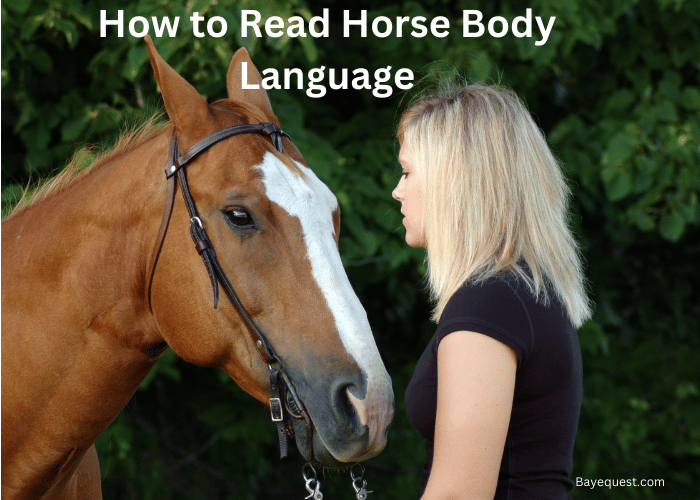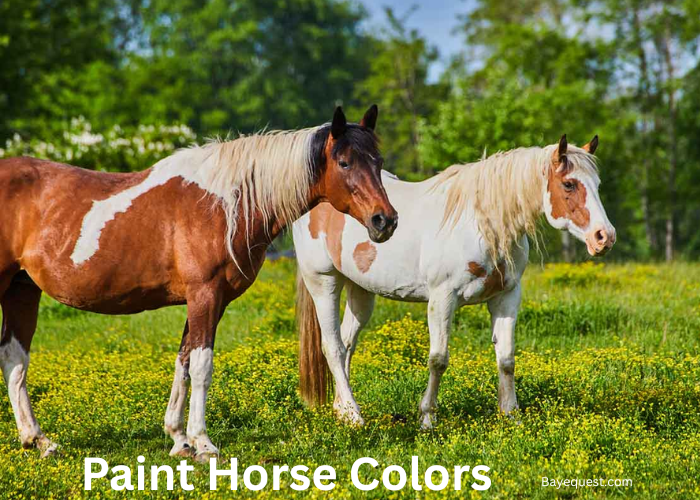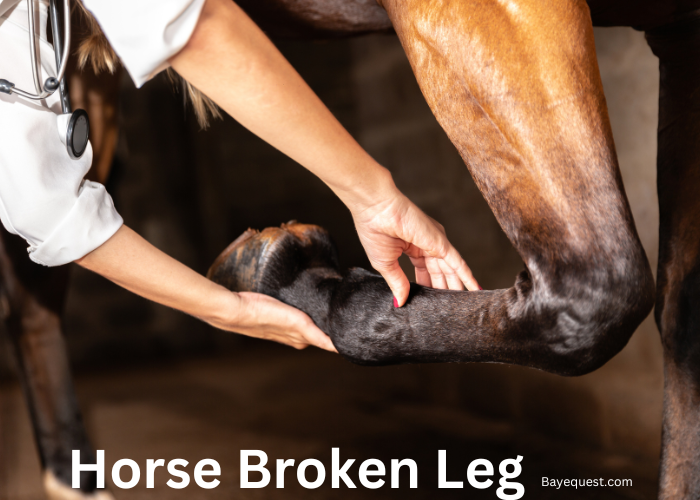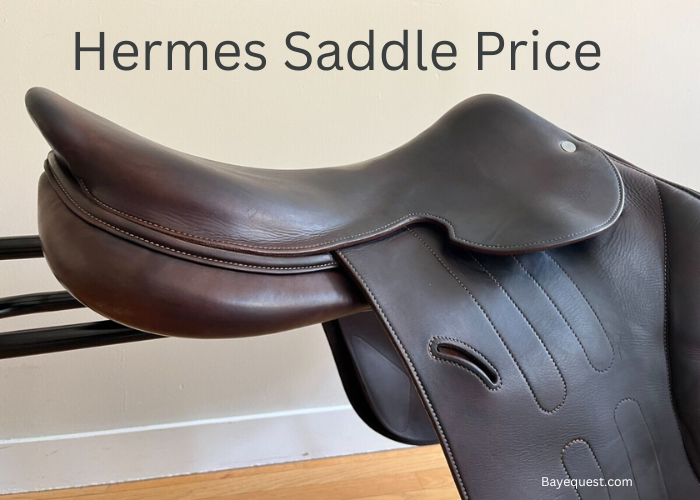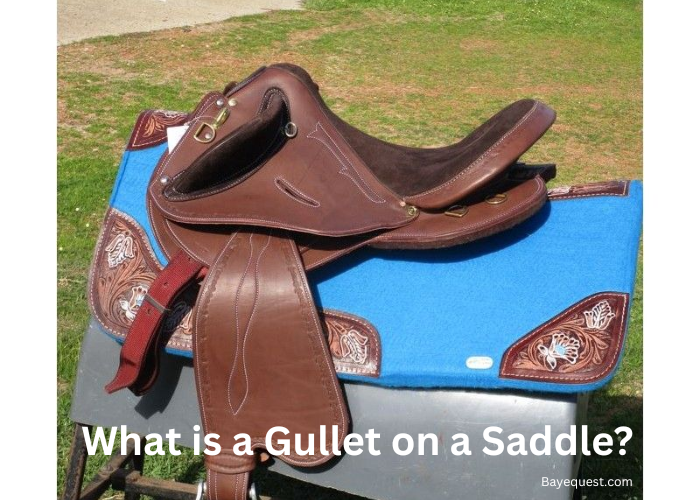Did you know horses communicate their emotions and intentions through distinct body signals? As an equine expert, I understand the subtleties of these majestic creatures.
Many horse enthusiasts struggle to interpret their horse’s cues, leading to misunderstandings or even safety issues. In this article, I’ll decode these signals, helping you build a deeper connection and improve your horse-handling skills.
Learn to read your horse like a pro, from ear flicks to tail swishes.
How to Read Horse Body Language Chart: Key Takeaway
This equine body language chart provides common horse body language signals and what they might indicate.
| Body Part | Signals |
|---|---|
| Ears | Turned out to the side, Turned back, Rapidly swiveling, Pinned, Turned forward |
| Eyes | Whites of the eyes showing, Tension, Rapid darting, Wide |
| Head | Lowered, Elevated, Snaking |
| Nostrils | Flared, Relaxed and soft, Twitching or quivering, Contracted or pinched |
| Neck | Relaxed, Arched, Stretched out, Elevated with tension, Swinging or tossing |
| Tail | Raised or “flagged”, Clamped down, Rapid swishing, Wringing |
| Forelegs | Standing splayed, Pawing, Stomping, Striking |
| Hindlegs | Raised, Cocked |
| Muzzle | Drooping lip or slack mouth, Chewing, Tight, pinched, or pursed mouth or muzzle, Clacking teeth, Gaping mouth with visible teeth, Flehmen’s response. |
| Whole Body | Tension, Trembling, Touching you, Swinging hindquarters, Rolling and lying down |
| Vocal | Sighing, Groaning, Nickering, Blowing or snorting, Neighing |
Basics of Equine Body Language
Horses, at their core, are prey animals. This shapes how they talk without words. Long ago, they needed to be quick to spot danger.
That’s why their body language is so rich. They use it to say, “I’m scared,” “I’m happy,” or “Watch out!”
When trying to understand what a horse is saying, look at the whole horse. It’s like putting together a puzzle.
All these pieces add up to an ear twitch, a foot stomp, or a tail swish. They tell you if a horse is relaxed, scared, or anything in between.
Getting this takes patience. Horses have their own time and way of showing feelings. It’s not always quick or clear.
So, sit back and watch. Do it again and again. Over time, you’ll start to see patterns. You’ll learn to speak horse, bit by bit.
Think of it as learning a new language. At first, it’s all strange sounds. But with time and practice, it starts to make sense. That’s how it is with horse body language.
Watch, learn, and soon you’ll understand the silent words of these beautiful creatures.
Why Horse Body Language Matters
Reading horse body language is key. It’s how we get close to these majestic animals. Think about it. Horses can’t talk the way we do. Instead, they use their bodies to express themselves.
When we understand what they’re saying, we can connect deeply. It’s like unlocking a secret code that lets us better care for them.
When you can tell if a horse is happy, scared, or upset just by looking, you can respond appropriately. This keeps both you and the horse safe and builds trust.
A horse that trusts you is more relaxed and easy to work with. This makes everything from riding to training smoother.
It’s also about respect. When we take the time to understand their language, we show horses we care. We say, “I see you. I hear you.” This respect goes both ways, creating a bond that’s hard to break.
In short, horse body language matters because it’s the foundation of a good relationship. It’s about safety, trust, and respect. Learning it can open a beautiful friendship with these incredible creatures.
11 Key Areas to Observe in Horses
Understanding horse behavior is crucial; here are 11 key areas to observe for better communication and safety.
1. Ears
Ears are like a horse’s antenna, catching signals and showing us what’s happening in their head. Let’s break it down: nice and simple.
Turned out to the side: When a horse’s ears are out to the side, it’s chill time. They’re relaxed, maybe grazing or just taking in the sights. It’s their way of saying, “All’s good here.”
Turned back: This can be a tricky one. Ears turned back might mean they’re listening to something behind them or to you if you’re riding. But, if those ears are flat back, watch out. It could be a sign they’re annoyed or feeling defensive.
Rapidly swiveling: Have you ever seen a horse with ears moving like they’re on fast-forward? They’re trying to catch sounds from all around, maybe unsure about something or figuring out where a noise is coming from. It’s their alert mode.
Pinned: This one’s a clear red flag. Ears pinned flat against the head? That horse is not happy. It might be fear, aggression, or irritation. Either way, it’s a sign to give them space and figure out what’s wrong.
Turned forward: Ears pricked forward are a good sign. The horse is curious and engaged and paying attention to something in front of it. If you’re leading or riding, it’s what you want to see. It means “I’m ready for what’s next.”
Each ear position tells a story, helping us understand how a horse feels at any moment. Listen with your eyes, and you’ll start speaking horse in no time.
2. Eyes
Eyes are the windows to a horse’s soul, revealing emotions and intentions. Here’s how to read their story.
Whites of the eyes showing: When you see the whites around a horse’s eyes, it’s a sign of stress or fear. They’re on high alert, maybe spooked by something they saw or heard. It’s a cue to be cautious and figure out what’s unsettling them.
Tension: A horse’s eyes can look tense, like when we’re worried. The area around the eye is tight, not soft and relaxed. This tension suggests the horse is not comfortable. They might be unsure or feeling pressured. It’s a hint to take things slow and easy.
Rapid darting: If a horse’s eyes move quickly, darting around, it’s scanning its surroundings. This behavior means the horse is nervous or looking for an escape route. It’s trying to take in as much information as possible, maybe feeling trapped or threatened.
Wide: Wide-open eyes can mean a couple of things. If something interests them, they’ll open wide to see better. But if those wide eyes come with tensed body language, it’s more about fear. They’re preparing for a fight-or-flight response. It’s important to recognize the difference.
Understanding these eye expressions and how horses see helps us respond appropriately and maintain their trust and respect. We can provide comfort and safety and deepen our bond with these magnificent animals by focusing on their eyes.
3. Head
A horse’s head position offers clear insights into their mood and intentions. Here’s a simple guide to what different head positions might mean.
Lowered: A horse with its head lowered is in a state of relaxation and contentment. It’s a sign of trust and comfort, often seen when a horse is grazing or resting. This position indicates the horse feels safe in its environment and with the people around it.
Elevated: When a horse raises its head high, it’s on high alert. This could mean the horse feels anxious, scared, or simply very attentive to something happening around it. An elevated head allows the horse to scan its surroundings more effectively, preparing for potential threats.
Snaking: A horse lowers its head and moves it from side to side, almost like a snake. It’s a more aggressive or dominant behavior, often used to assert control or dominance over another horse or to express displeasure. If you see a horse snaking its head towards you, it’s a warning to back off and give the horse some space.
Related read: Why Horses Nod their Heads.
4. Nostrils
Horse nostrils are not just for breathing. They’re also key in expressing emotions and physical states. Here’s how to interpret what they’re telling you.
Flared nostrils: This is one of the most noticeable signs. When a horse flares its nostrils, it’s usually because they need more air, often due to excitement, exertion, or stress. It can signal that the horse is alert and focusing on something in its environment, possibly something it sees as a threat or a challenge.
Relaxed and soft: The horse is likely calm and content if its nostrils are relaxed and its edges soft. The “all is well” signal indicates that the horse feels safe and that nothing in its immediate surroundings causes stress or fear.
Twitching or quivering: Sometimes, you might see a horse’s nostrils twitch or quiver. This can be a sign of anticipation or nervousness. The horse might be unsure about something and trying to determine how to react. Twitching or quivering is a more subtle sign than flaring, but equally important.
Contracted or pinched: When a horse contracts its nostrils, making them smaller, it might indicate irritation or discomfort. This could be due to various reasons, from physical pain to disliking a particular smell.
5. Neck
A horse’s neck is like a mood ring, reflecting their emotional state and intentions. Here’s how to read the subtle and not-so-subtle cues.
Relaxed: A relaxed neck, often with a natural curve, shows the horse is calm and comfortable. In this state, the muscles are loose, and the neck might lower, especially as the horse grazes or rests. It’s a sign of trust and contentment in their environment.
Arched: When a horse arches its neck, it displays confidence or excitement. Sometimes, it also shows attentiveness to something interesting or appealing. However, an overly arched neck, especially with tension, can indicate stress or defensiveness.
Stretched out: A horse stretching its neck forward and down often tries to investigate something or show relaxation. This posture can also be seen when the horse’s trying to reach something just out of reach, like a tempting patch of grass. If the stretch is more horizontal, it could be a sign of curiosity or exploration.
Elevated with tension: A high, stiff neck is a clear signal of alertness or anxiety. The horse is likely feeling threatened or unsure, raising its neck to appear larger or to get a better view of potential dangers. This position often comes with other signs of tension in the body, signaling the horse is on high alert.
Swinging or tossing: A horse swinging or tossing its neck might be trying to relieve discomfort or resist something it doesn’t like. It can also signify frustration or an attempt to assert dominance.
6. Tail
Like the rest of a horse’s body, the tail is a powerful communicator. Here are what different tail movements and positions can tell you.
Raised or “flagged”: When a horse raises its tail high, it’s often a sign of high energy or excitement. This can be seen in playful moments or when the horse runs freely. However, a raised tail can also indicate alertness to something unusual or interesting in their environment. It’s a signal worth noting, especially with other body language cues.
Clamped down: A tail clamped down tightly against the body suggests tension or fear. The horse might be trying to protect itself, feeling cold, or experiencing stress. This is a clear sign the horse is not at ease with the current situation, and caution should be used in approaching or handling them.
Rapid swishing: A tail moving back and forth quickly is usually a sign of irritation or annoyance. This could be in response to flies or other pests, but it can also indicate discomfort with something in their environment or how they’re being handled. It’s a reminder to check for potential causes of discomfort.
Wringing: When a horse twists its tail or moves it in a wringing motion, it’s often a sign of severe irritation or discomfort. This could be due to physical pain or extreme annoyance. Observing this behavior is a cue to assess the situation carefully.
Interesting read: How Long is a Horse Tail Without Hair?
7. Forelegs
Much like the rest of their body, the forelegs of a horse offer clear insights into their feelings and intentions. Here’s how to interpret their actions:
Standing splayed: If a horse stands with its front legs splayed apart, it might indicate discomfort or instability. This position can suggest the horse is trying to balance itself or relieve pressure from a certain part of its body. It’s often a sign to check for potential health issues or ensure the horse feels secure in its environment.
Pawing: When a horse paws on the ground with its front leg, it can mean several things. Sometimes, it’s a sign of impatience or frustration, like when it’s tied up and wants to move. Other times, it might be a way to explore its surroundings, especially on unfamiliar ground. Pawing can also indicate anxiety or excitement about something it anticipates, such as feeding time.
Stomping: A horse that stomps its foreleg usually tries to shake off something irritating, like flies. However, repeated stomping can also be a sign of discomfort or stress. It’s a more forceful way to express annoyance than simple tail swishing or skin twitching.
Striking: Striking out with a foreleg is an aggressive behavior and a clear warning sign. A horse might do this if it feels threatened or needs to defend itself. This action can be directed at other horses, animals, or people.
8. Hind legs
The hind legs of a horse can communicate a lot about their mood and intentions. Here’s a simple breakdown:
Raised: When a horse raises a hind leg, it’s a warning. This could mean the horse is preparing to kick due to fear, irritation, or a need to defend itself. If a horse raises its hind leg in your direction, take it seriously. It’s a clear sign to give the horse space and reassess the situation to prevent accidents or injuries.
Cocked: If a horse has one hind leg cocked, with the hoof resting off the ground, it’s usually a sign of relaxation. This position indicates the horse is at ease and comfortable enough to shift its weight and rest a leg.
Read also: Is a Horse Kick Strong?
9. Muzzle
A horse’s muzzle is expressive, offering insight into their emotional and physical state. Let’s decode these signals:
Drooping lip or slack mouth: When a horse’s lip droops or its mouth looks slack, it’s usually a sign of relaxation and contentment. This indicates the horse feels calm and comfortable in its environment or after exercise.
Chewing: Chewing without food in the mouth can be a sign of thoughtfulness or processing. It’s often seen in young horses as a submissive gesture or in adult horses when relaxing and thinking things over.
Clacking teeth: Young horses often clack their teeth as a submissive gesture towards older, more dominant horses. It’s saying, “I’m just a baby, don’t hurt me.” In hand-reared or very young horses, you might also see this behavior towards humans as they figure out their social standing.
Tight, pinched, or pursed mouth or muzzle: A tight or pinched mouth indicates tension or discomfort. The horse might be stressed, anxious, or in pain. This is a cue to check for any issues causing the horse distress.
Gaping mouth with visible teeth: If a horse has a gaping mouth showing teeth, especially if accompanied by other aggressive body language, it might be preparing to bite. This is a sign of aggression or defense. It could be directed towards other horses or humans if the horse feels threatened or cornered.
Find out other reasons why horses bite in our next article.
Flehmen’s response is when a horse curls its upper lip, exposing its teeth, and inhales. Horses use the Flehmen response to analyze scents more, especially those related to mating or marking territory. It’s not a sign of aggression but curiosity and sensory investigation.
10. Whole body
Reading a horse’s whole body gives you a comprehensive view of its mood and health. Let’s dive into what these broader signals mean.
Tension: A tense horse has a stiff posture, with muscles that look hard and maybe even quiver slightly. This tension could mean the horse is anxious, scared, or preparing to flee or fight. Recognizing this can help you respond to calm the horse or address whatever is causing its stress.
Trembling: Trembling can indicate several things. It could be from physical exertion, cold, fear, or extreme pain. Context is crucial here. If it’s not cold and the horse hasn’t been working hard, trembling is a sign something is wrong, emotionally or physically.
Touching you: When a horse deliberately touches you with its nose or body, it’s often a sign of affection, curiosity, or seeking comfort. This gesture shows trust and a positive bond between you and the horse. It’s their way of connecting or asking for attention.
Swinging hindquarters: A horse swinging towards you or another horse can be a warning or a sign of irritation. It’s a defensive posture, suggesting the horse might kick if it feels further threatened. Always approach horses from the side and make your presence known to avoid startling them.
Rolling and lying down: Horses roll and lie down for several reasons. Rolling is often a way to scratch their backs, get comfortable, or show contentment. However, if a horse rolls excessively and seems uncomfortable, it might indicate colic, ulcers or other distress. Lying down, especially relaxed and in a safe environment, can indicate contentment or sleep. Again, context is key to understanding these actions.
Related read: Ways to Naturally Treat Ulcers in Horses.
11. Vocal language
Horses use vocalizations as their body language to communicate with us and each other. Here’s a simple guide to understanding horse sounds.
Sighing: A horse’s sighing is often a sign of relaxation or release of tension, similar to when we sigh in relief. It can happen after exercise when the horse is settling down to rest or if something previously bothering them is no longer a concern.
Groaning: Depending on context, groaning can have a few different meanings. Sometimes, it’s just a sign of contentment, especially if they eat something enjoyable. However, groaning can also indicate discomfort or pain.
Nickering: A soft, low nicker is a greeting sound. Horses nicker to say hello to their human caretakers or horse friends. It’s a sign of recognition and often affection. Mares also nicker to their foals in a soothing tone.
Blowing or snorting: Blowing or snorting can signal different things. A soft blow might be a horse clearing its nostrils. A sharp snort, however, is often a way to alert others about something unusual or potentially threatening. It can also be a sign of excitement or curiosity.
Neighing: Neighing, or whinnying, is a louder, more prolonged sound that can carry over long distances. Horses use it to communicate with others, not within sight, maybe calling out to a friend or expressing loneliness or frustration. The tone of the neigh can indicate whether it’s a happy call or one of distress.
Interpreting Common Horse Behaviors and Language of Horses
Understanding common horse behaviors can significantly enhance how you interact with them, ensuring both your safety and their well-being. Here’s a simple breakdown:
Approachable behaviors
- Head lowered with a calm demeanor.
- Ears forward or relaxed, showing interest or contentment.
- Soft eye expression, possibly with a slow blinking.
- Standing still, allowing you to approach.
Unapproachable behaviors
- Turning their hindquarters towards you is potentially a prelude to kicking.
- Ears pinned back, indicating annoyance or aggression.
- Stiff body posture or attempts to move away from you.
- Snorting or stamping, signalling discomfort or warning.
Signs of stress, fear, or anxiety
- Wide eyes with the whites showing.
- Rapid, shallow breathing or holding breath.
- Sweating excessively, especially if not after exercise.
- Shaking or trembling.
- Tail swishing rapidly or clamped down.
- Constantly looking around or attempting to flee.
Indicators of relaxation and contentment
- Soft, half-closed eyes, often accompanied by slow blinking.
- Lowered head and neck in a natural, relaxed posture.
- Sighing and chewing motions, even when not eating.
- Standing with one hind leg cocked, resting comfortably.
- A smooth, calm tail movement.
Aggressive behaviors and warnings
- Showing teeth or snapping is a clear sign of aggression or discomfort.
- Kicking out or raising a hind leg as a warning or if feeling threatened.
- Striking with front legs, especially when feeling cornered or to assert dominance.
- Loud neighing or squealing can signal distress or be part of aggressive interactions.
Read also: Causes and Treatment of Equinophobia.
Practical Tips for Communicating With Horses
Communicating effectively with horses requires patience, observation, and a respectful approach. Here are some practical tips to enhance your communication and strengthen your bond with these majestic animals:
- Stay calm and patient
- Observe before acting
- Use a consistent approach
- Respect their space
- Positive reinforcement
- Be predictable
- Learn from each other
- Voice and touch
- Body language is key
- Training sessions
Horse Language FAQs
How can you tell if a horse likes you?
If a horse likes you, it shows through affectionate gestures. They might nuzzle you, a sign of affection. Horses that like you will follow you, showing trust. Look for relaxed body language and soft eyes. This means they are comfortable with you. They might also nicker when they see you, a friendly greeting.
Related read: How Do Horses Show Affection?
How can you tell if a horse dislikes you?
When a horse dislikes you, it’s more guarded. They might avoid you or turn away, showing discomfort or distrust. A horse that dislikes someone may also show signs of irritation, like pinned ears or a swishing tail. They keep their distance. This behavior indicates they’re not yet comfortable with you.
How can you tell if a horse is happy?
A happy horse has a relaxed posture and a calm demeanor. They will have a soft gaze and might even sigh contentedly. Happy horses enjoy engaging with others, showing curiosity and a willingness to interact. Their movements are smooth, and they’re responsive without tension.
What does it mean when a horse stares at you?
If a horse stares at you, it’s assessing you. It might be curious or trying to understand your intentions. A direct stare with a relaxed body could mean curiosity. The stare might be more about caution or uncertainty if the horse’s body is tense.
Conclusion
Mastering horse body language isn’t just about care or training. It’s the essence of forming a profound bond with these majestic creatures.
This journey into their world of silent communication teaches us patience, empathy, and respect. Each gesture and sound offers insight into their thoughts and feelings.
As we apply these lessons, we don’t just become better handlers—we become trusted companions. Remember, every horse has a unique way of speaking.
Now, check out our guide on cast horses to know what causes it, how to handle it, and ways to prevent it.




